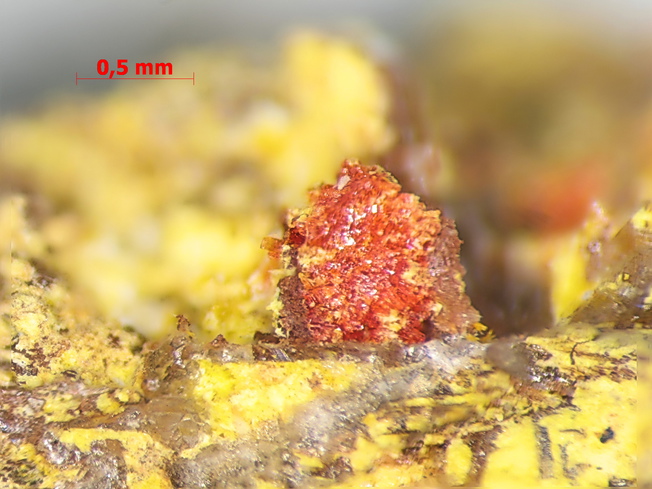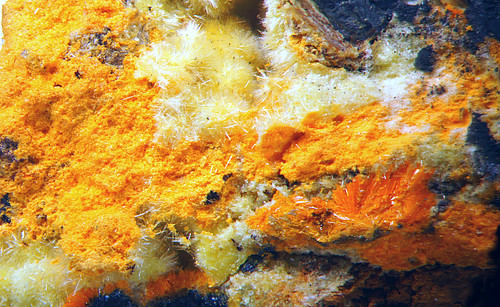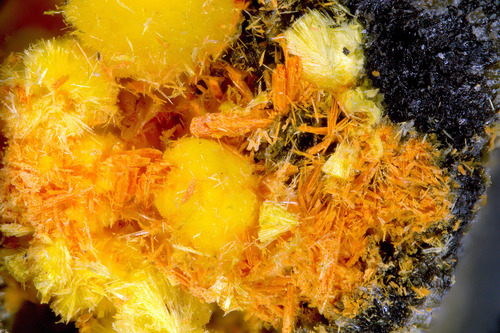Spriggite
A valid IMA mineral species
This page is currently not sponsored. Click here to sponsor this page.
About Spriggite
Formula:
Pb3(UO2)6O8(OH)2 · 3H2O
Colour:
Bright orange
Lustre:
Vitreous
Hardness:
4
Specific Gravity:
7.64 (Calculated)
Crystal System:
Monoclinic
Name:
Named in honor of Reginald Claude Sprigg (1 March 1919, Yorketown, South Australia, Australia - 2 December 1994, Glasgow, Scotland), government geologist in South Australia, and conservationalist. He discovered the Pre-Cambrian fossils at Ediacara Hills and is co-author of "Uranium deposits of South Australia". He also founded the popular Arkaroola Wilderness Sanctuary.
Unique Identifiers
Mindat ID:
25685
Long-form identifier:
mindat:1:1:25685:4
GUID
(UUID V4):
(UUID V4):
44d87e57-de2f-46e4-8e75-214151e1bd11
IMA Classification of Spriggite
Approved
Approval year:
2002
First published:
2004
Type description reference:
Classification of Spriggite
4.GC.15
4 : OXIDES (Hydroxides, V[5,6] vanadates, arsenites, antimonites, bismuthites, sulfites, selenites, tellurites, iodates)
G : Uranyl Hydroxides
C : With additional cations; with mainly UO2(O,OH)6 hexagonal polyhedra
4 : OXIDES (Hydroxides, V[5,6] vanadates, arsenites, antimonites, bismuthites, sulfites, selenites, tellurites, iodates)
G : Uranyl Hydroxides
C : With additional cations; with mainly UO2(O,OH)6 hexagonal polyhedra
Mineral Symbols
As of 2021 there are now IMA–CNMNC approved mineral symbols (abbreviations) for each mineral species, useful for tables and diagrams.
| Symbol | Source | Reference |
|---|---|---|
| Sgg | IMA–CNMNC | Warr, L.N. (2021). IMA–CNMNC approved mineral symbols. Mineralogical Magazine, 85(3), 291-320. doi:10.1180/mgm.2021.43 |
Physical Properties of Spriggite
Vitreous
Transparency:
Transparent
Colour:
Bright orange
Streak:
Pale orange
Hardness:
4 on Mohs scale
Tenacity:
Brittle
Cleavage:
Distinct/Good
Good on (100).
Good on (100).
Fracture:
Irregular/Uneven
Density:
7.64(6) g/cm3 (Calculated)
Optical Data of Spriggite
Type:
Biaxial
Pleochroism:
Strong
Comments:
Pale yellow to dark orange, in polarized light.
Comments:
n(min) = 1.807 n(max) = 1.891.
Chemistry of Spriggite
Mindat Formula:
Pb3(UO2)6O8(OH)2 · 3H2O
Elements listed:
Crystallography of Spriggite
Crystal System:
Monoclinic
Class (H-M):
2/m - Prismatic
Space Group:
B2/b
Setting:
C2/c
Cell Parameters:
a = 28.355(9) Å, b = 11.990(4) Å, c = 13.998(4) Å
β = 104.248(5)°
β = 104.248(5)°
Ratio:
a:b:c = 2.365 : 1 : 1.167
Unit Cell V:
4,612.60 ų (Calculated from Unit Cell)
Z:
8
Morphology:
Aggregates of randomly oriented prismatic crystals. Forms include the {100} prism (dominant), another prominent pinacoid and four small terminal faces (type material).
Twinning:
By penetration of three individuals separated by ~60° rotation around [100] to form six-legged stars.
Crystal Structure
Load
Unit Cell | Unit Cell Packed
2x2x2 | 3x3x3 | 4x4x4
Unit Cell | Unit Cell Packed
2x2x2 | 3x3x3 | 4x4x4
Show
Big Balls | Small Balls | Just Balls | Spacefill
Polyhedra Off | Si Polyhedra | All Polyhedra
Remove metal-metal sticks
Big Balls | Small Balls | Just Balls | Spacefill
Polyhedra Off | Si Polyhedra | All Polyhedra
Remove metal-metal sticks
Display Options
Black Background | White Background
Perspective On | Perspective Off
2D | Stereo | Red-Blue | Red-Cyan
Black Background | White Background
Perspective On | Perspective Off
2D | Stereo | Red-Blue | Red-Cyan
View
CIF File Best | x | y | z | a | b | c
CIF File Best | x | y | z | a | b | c
Rotation
Stop | Start
Stop | Start
Labels
Console Off | On | Grey | Yellow
Console Off | On | Grey | Yellow
Data courtesy of the American Mineralogist Crystal Structure Database. Click on an AMCSD ID to view structure
| ID | Species | Reference | Link | Year | Locality | Pressure (GPa) | Temp (K) |
|---|---|---|---|---|---|---|---|
| 0003406 | Spriggite | Brugger J, Krivovichev S V, Berlepsch P, Meisser N, Ansermet S, Armbruster T (2004) Spriggite, Pb3[(UO2)6O8(OH)2](H2O)3, a new mineral with beta-U3O8 - type sheets: Description and crystal structure American Mineralogist 89 339-347 |  | 2004 | 0 | 293 |
CIF Raw Data - click here to close
X-Ray Powder Diffraction
Powder Diffraction Data:
| d-spacing | Intensity |
|---|---|
| 3.10 Å | (100) |
| 3.46 Å | (80) |
| 6.92 Å | (60) |
| 1.918 Å | (60) |
| 6.02 Å | (30) |
| 2.74 Å | (30) |
| 2.01 Å | (30) |
Comments:
Mount Painter No. 2 workings, North Flinders Ranges, South Australia, Australia. Data from the type description.
Geological Environment
Paragenetic Mode(s):
| Paragenetic Mode | Earliest Age (Ga) |
|---|---|
| Stage 7: Great Oxidation Event | <2.4 |
| 47a : [Near-surface hydration of prior minerals] | |
| 47f : [Uranyl (U⁶⁺) minerals] |
Type Occurrence of Spriggite
General Appearance of Type Material:
Prismatic crystals to 0.15 mm, forming aggregates to 1 cm across.
Place of Conservation of Type Material:
Musée géologique cantonal, Lausanne, Switzerland (MGL68937) and South Australian Museum, Adelaide, South Australia (G27305).
Geological Setting of Type Material:
Strongly oxidized samples of a quartz-hematite breccia enriched in uranium, niobium and rare earth element minerals.
Associated Minerals at Type Locality:
Reference:
Brugger J, Krivovichev S V, Berlepsch P, Meisser N, Ansermet S, Armbruster T (2004) Spriggite, Pb3[(UO2)6O8(OH)2](H2O)3, a new mineral with β-U3O8-type sheets: Description and crystal structure. American Mineralogist 89, 339-347
Synonyms of Spriggite
Other Language Names for Spriggite
Common Associates
Associated Minerals Based on Photo Data:
| 1 photo of Spriggite associated with Parauranophane | Ca(UO2)2(SiO3OH)2 · 5H2O |
| 1 photo of Spriggite associated with Wölsendorfite | Pb7(UO2)14O19(OH)4 · 12H2O |
| 1 photo of Spriggite associated with Sklodowskite | Mg(UO2)2(SiO3OH)2 · 6H2O |
Related Minerals - Strunz-mindat Grouping
| 4.GC. | Bobfinchite | Na[(UO2)8O3(OH)11] · 10H2O |
| 4.GC.05 | Clarkeite | (Na,Ca,Pb)(UO2)O(OH) · 0-1H2O |
| 4.GC.10 | Umohoite | (UO2)MoO4 · 2H2O |
Fluorescence of Spriggite
Not fluorescent.
Other Information
Health Risks:
No information on health risks for this material has been entered into the database. You should always treat mineral specimens with care.
Internet Links for Spriggite
mindat.org URL:
https://www.mindat.org/min-25685.html
Please feel free to link to this page.
Please feel free to link to this page.
Search Engines:
External Links:
Mineral Dealers:
References for Spriggite
Reference List:
Brugger, Joël, Krivovichev, Sergey V., Berlepsch, Peter, Meisser, Nicolas, Ansermet, Stefan, Armbruster, Thomas (2004) Spriggite, Pb3[(UO2)6O8(OH)2] (H2O)3, a new mineral with β-U3O8–type sheets: Description and crystal structure. American Mineralogist, 89 (2) 339-347 doi:10.2138/am-2004-2-312
Mandarino, Joseph A. (2004) New minerals. The Canadian Mineralogist, 42 (4) 1241-1260 doi:10.2113/gscanmin.42.4.1241
Brugger, Joël, Krivovichev, Sergey V., Berlepsch, Peter, Meisser, Nicolas, Ansermet, Stefan, Armbruster, Thomas (2004) Spriggite, Pb3[(UO2)6O8(OH)2] (H2O)3, a new mineral with β-U3O8–type sheets: Description and crystal structure. American Mineralogist, 89 (2) 339-347 doi:10.2138/am-2004-2-312
Localities for Spriggite
Locality List
 - This locality has map coordinates listed.
- This locality has map coordinates listed.
 - This locality has estimated coordinates.
ⓘ - Click for references and further information on this occurrence.
? - Indicates mineral may be doubtful at this locality.
- This locality has estimated coordinates.
ⓘ - Click for references and further information on this occurrence.
? - Indicates mineral may be doubtful at this locality.
 - Good crystals or important locality for species.
- Good crystals or important locality for species.
 - World class for species or very significant.
(TL) - Type Locality for a valid mineral species.
(FRL) - First Recorded Locality for everything else (eg varieties).
- World class for species or very significant.
(TL) - Type Locality for a valid mineral species.
(FRL) - First Recorded Locality for everything else (eg varieties).
All localities listed without proper references should be considered as questionable.
Australia (TL) | |
| Brugger et al. (2003) +3 other references |
DR Congo | |
| Joy Desor specimen and analysis. |
Quick NavTopAbout SpriggiteUnique IdentifiersIMA Classification Classification Mineral SymbolsPhysical Properties Optical Data Chemistry Crystallography Crystal StructureX-Ray Powder DiffractionGeological EnvironmentType Occurrence SynonymsOther LanguagesCommon AssociatesStrunz-MindatFluorescence Other InformationInternet Links References Localities Locality List







 symbol to view information about a locality.
The
symbol to view information about a locality.
The 



Shinkolobwe Mine, Shinkolobwe, Kambove Territory, Haut-Katanga, DR Congo